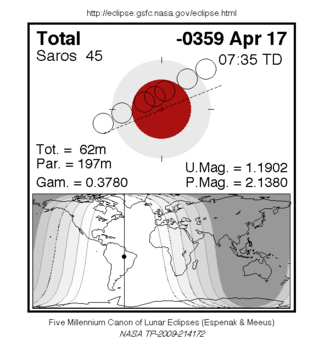Lunar eclipse from 16./17. April 360 BC Chr.

The lunar eclipse of 16./17. April 360 BC Chr. (-359 according to astronomical time calculation ) is handed down in several Babylonian cuneiform notes, which belong to the genre of the ACT texts . The 16th/17th indicated in the Julian calendar system . April 360 BC When converted to today's Gregorian calendar, the 11th / 12th century BC . April 360 BC The cuneiform tablets BM 35115, BM 35789 and BM 45640 are currently in the British Museum in London .
These records are of particular importance because they refer to the Achaemenid king Artaxerxes II and his 45th year of reign, in which Pharaoh Tachos came to the throne in Egypt . The lunar eclipse could be observed directly in Babylonia and Egypt in its initial stage up to about the first partial phase, as it began there in the early morning hours. In North America , the lunar eclipse could already be followed in the evening hours of April 16; there it ended shortly after midnight on April 17th.
First translations
The Assyriologist Johann Strassmaier and the astronomers Josef Epping and Franz-Xaver Kugler first began to translate the Babylonian-astronomical cuneiform text.
The outstanding research achievements of the time were continued by Otto Neugebauer , among others . In 1955 the three-volume standard work Astronomical cuneiform Texts - Babylonian ephemerides of the Seleucid period for the motion of the sun, the moon, and the planets , which still forms the basis of Babylonian astronomical history to this day, was published.
Babylonian texts
The astronomical event mentioned was a total lunar eclipse that had to be dated precisely based on the information in the cuneiform text. By checking with other historical eclipses, it was found that the historical dates deviate from the back-calculated values. The corresponding time difference is referred to as " Δ T ".
Taking into account the Δ T , the lunar eclipse in Babylonia began around 3:35 a.m. on April 17 , 360 BC. And reached its maximum around 6:10 am. In Egypt, the lunar eclipse was observable a little longer. The exact times have not been preserved in the Babylonian cuneiform tablets due to severe damage:
"[Artaxerxes II.] 45th year: First month (Nisannu) day 10+ [.], [...] until sunrise [...] from [...] [..]."
See also
literature
- Josef Epping, Johann-Nepomuk Strassmeier: Astronomical things from Babylon or the knowledge of the Chaldeans about the starry sky . Herder, Freiburg 1889, ( parts from Maria-Laach supplementary books 44).
- Franz-Xaver Kugler : astronomy and star service in Babel . Volume 1: Development of Babylonian Planetary Studies from its Beginnings to Christ. According to mostly unpublished sources from the British Museum . Aschendorff, Münster 1907.
- Otto Neugebauer : The exact sciences in antiquity . Unabridged, slightly corrected reprint of the 2nd edition, Brown University Press, 1957. Dover Publications, New York NY 2004, ISBN 0-486-22332-9 , ( Dover classics of science and mathematics ).
- Otto Neugebauer (Ed.): Astronomical cuneiform Texts. Babylonian ephemerides of the Seleucid period for the motion of the sun, the moon, and the planets . Reprint edition. 3 volumes. Springer, New York NY et al. 1983, ISBN 0-387-90812-9 , ( Sources in the history of mathematics and physical sciences 5), (the original edition appeared: Humphries, London 1955).
- Abraham J. Sachs: Astronomical Diaries and related Texts from Babylonia . Volume 5: Hermann Hunger (Ed.): Lunar and Planetary Texts . Including materials by Abraham J. Sachs. With an appendix by John M. Steele. Publishing house of the Austrian Academy of Sciences, Vienna 2001, ISBN 3-7001-3028-7 , ( Austrian Academy of Sciences - Philosophical-Historical Class - Memoranda 299).
- Francis Richard Stephenson : Historical Eclipses and Earth's rotation . Cambridge University Press, Cambridge 1997, ISBN 0-521-46194-4 .
Remarks
- ↑ a b Date in the proleptic Julian calendar .
- ^ Jean Meeus : Astronomical Algorithms - Applications for Ephemeris Tool 4,5 - , Barth, Leipzig 2000 for: Ephemeris Tool 4,5 according to Jean Meeus, conversion program, 2001 .
- ↑ First contact to the first partial phase about 57 minutes; Duration of the first partial phase up to totality about 67 minutes; Duration of totality about 62 minutes; subsequent duration of the second partial phase 67 minutes; thereafter the last contact takes about 57 minutes.
- ^ A b Hermann Hunger: Lunar and Planetary Texts . P. 395.
- ↑ 3 hours and 47 minutes.
- ↑ Beginning in Egypt around 3:10 a.m. local time ( Memphis / Aswan ); Sunrise in Egypt around 5:30 a.m. local time.
- ^ The 1st Nisannu began on April 5th, 360 BC. Chr.
- ↑ The sunrise occurred around 5:34 a.m. local time.